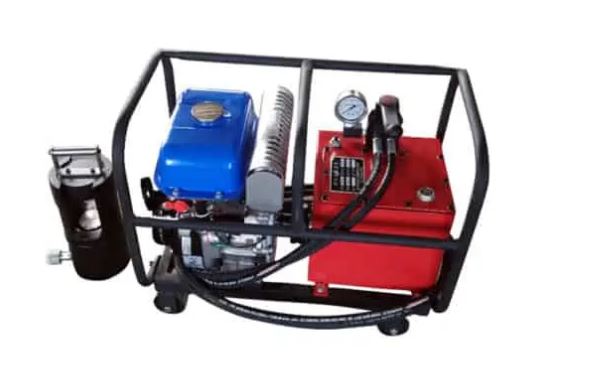Energy
How gas powered hydraulic pump can help you in emergency situations?
Published
2 years agoon
By
Olu Emmanuel
Gas powered hydraulic pump is high pressure pumps that provide hydraulic power using compressed gas. Gas hydraulic pumps are employed in various settings, such as automobile brakes, construction machinery, and industrial equipment. The first gas hydraulic pump was created in the early 19th century, and today businesses like Enerpac manufacture them. Gas hydraulic pumps are often more expensive than other types, but they have several benefits, such as higher flow and pressure rates and longer lifespans. Many commercial and industrial processes need the use of gas hydraulic pumps.
While there are various hydraulic pumps, each type is distinguished by utilizing pressurized liquids to complete a task. For instance, hydraulic water pumps use the inherent qualities of water to transfer water from one location to another. In a mechanical system, hydraulic piston pumps and gear pumps to aid in activating a piston’s movement.
Each submersible pump comes in a wide variety, but they can all be converted to electrical energy. In these situations, an electric current is sent to a motor that drives impellers or other devices that create level divergences within the pump system. These differential pressure levels make the movement of liquid through the pump. These pump systems can direct hydraulic power to commercial elevators or industrial machines like excavators.
Although there are many distinct types of hydraulic machinery, piston actuators are among the more used ones. A hydraulic cylinder containing a piston and an empty, fluid-tight chamber make up a hydraulic piston actuator. When hydraulic fluids flow within one end of the cylinder, it compels the pistons to move into the open room because the piston head is firmly sealed towards the sides of the cylinder.
This compels anything that might be attached to the cylinder to move. This is how many different types of hydraulic machinery, including hydraulic jacks and lifts, operate. The materials used to create hydraulic fluid might vary greatly depending on the application. Oils are the most often used hydraulic fluids in heavy-duty industrial applications. This entire procedure is made feasible in an electric pneumatic system by the electricity flowing into the motor pump; this enables the lubricating oil to be pushed into or drained from the cylinder whereby the pump is linked.
The pressure-compensated, variable-displacement aeroplane hydraulic pump modifies the amount of fluid produced to keep constant pressure; as per MIL-P-19692 [34] & AS595 in both nutrient fluid and phosphate ester hydraulic fluid, the design of aviation hydraulic pumps should be certified. Both helicopter and aeroplane engines, as well as an AC motor, can power a hydraulic pump. A hydraulic pump must deliver
- Typical rotating group providing fluid with constant pressure and variable displacement
- Long life with high pressure and speed
- A high-performance pump system can react swiftly to variations in flow demand with precision.
- The least amount of pressure ripple to boost system dependability
The sloped angle of a hydraulic pump’s hydraulic cylinder regulates the displaced volume. The discharge pressure that passes through the compensator valve & stroking piston holds the tip of the swash plate.
Three-way solenoid valve, regulated by the pressure difference on the valve spool area as opposed to the predetermined compensator spring force, is used by a hydraulic pump to control pump output pressure. The valve spool rotates and alters the swash-plate angle if the external load varies.
Hydraulic pumps transform electrical power into fluid pressure using an electronic motor driver pump. Every hydraulic drive requires these. Hydraulic fluid then transmits the appropriate volume and pressure of the liquid to the cylinders, actuators, and hydraulic motors. Hydraulic pumps typically work at higher speeds and pressure than hydraulic motors. Most gate drives use a directional pump with just a directional valve to invert the functioning of the actuators. However, some motor drives use reversible pumps. The three fundamental types of hydraulic systems are gear, piston, and vane, just like hydraulic motors. It is customary and advised [1] within USACE to supply backup electric drive motors and hydraulic pumps. Each pump drives the hydraulic system and is identically proportioned for the necessary loads. Every time the gates are opened, the pumps are cycled. The hydraulic pump & electric motor are now done as a part of an HPU package in the majority of USACE gates drives.
Pumps can be positive displacement, constant displacement, or variable displacement. The volume of a fixed pumping system is governed by the pump’s capacity and the electric motor’s speed. Internally and externally, gear pumps, radial and axial piston pumps screw pumping systems, and vane pumps are fixed displacement pumps. Vane pumps, often used for variable flow or displacement, are designed and built as variable volume pumps.
The gear pump is the most straightforward and durable positive displacement pump, with only two functional elements. Gear pumps are generally silent, have a high fluid contamination tolerance, and have good overall efficiency. When liquid contamination is a persistent worry, gear pumps are probably a better option. These pumps’ flow rate & speed properties are linear throughout their effectiveness ranges, even though their volume is fixed at a specific speed (in rpm). Driven by a variable-speed motor drive, a reversible geared pump can be used to control the speed and direction of a drive system.
When electrical power is not available, internal combustion engine hydraulic power units provide hydraulic chainsaws, log splitters, or other mobile instruments with power. Gas-powered hydraulic power units, called engine-driven power packs, offer greater flow rates than DC hydraulic power units. Compared to conventional mechanical parts, they offer greater force, enabling hydraulic power systems to lift and move big loads with less space required. Over a wide variety of speeds and load weights, they also offer precision movement and speed control.
Wheeled mobile carts with a built-in gas-powered hydraulic unit can be moved around the construction site as needed. The wheels may be moved on various surfaces, including asphalt and dirt. The unit operates portable instruments like chainsaws in rural locations without quick access to electricity. It also powers hydraulic tools.
Trending

 Latest1 week ago
Latest1 week agoOne shot as detained soldiers break out of ‘overcrowded cells’ to protest poor feeding

 Aviation6 days ago
Aviation6 days agoKeyamo engages Air France-KLM, advocates affordable low fare offers

 News2 days ago
News2 days agoYahaya Bello’s Wife, Amina Oyiza Bello disqualified from being appointed Judge

 Featured4 days ago
Featured4 days agoAGAIN! Another Commissioner resigns in Rivers

 Featured5 days ago
Featured5 days agoAnambra State gets new Police Commissioner

 Covid-196 days ago
Covid-196 days agoHow big pharma paid us to vaccinate children—Pediatrician

 Business1 day ago
Business1 day agoMTN Group CEO canvasses regulatory harmony across Africa

 Crime3 days ago
Crime3 days agoUpdate: I was kidnapped, laced with explosives to rob bank – Plateau suspect




